The Food Literature Group meets four or five times each year to discuss books relevant to Slow Food values and food as an expression of community and cultural heritage. Along with wonderful conversation, we also share a potluck dinner at the meeting or gather at a local restaurant that reflects the theme of chosen book. We’ve even been seen picnicking at Stanford’s Rodin Sculpture Garden on a summer evening.
The Food Literature Group is open to all current Slow Food South Bay chapter members. Please email us if you have an interest in joining this group at:
literature[at-sign]ourdomain[dot]org
2015 Books & Gatherings
JOIN US on MONDAY, NOVEMBER 9th. Our fearless readers will gather to dine and toast the talents of an Escoffier-cooking hunter gatherer and forager, author Steven Rinella’s Scavenger’s Guide to Haute Cuisine. As a sportsman from Montana and freelance writer, Rinella’s humorous accounts of his adventures scouting ingredients across several states tell the tales of how he ‘shopped’ for his epic 3-day, 54-course meal he wanted to prepare for his friends using the recipes put forth in the 1903 classic by Escoffier Le Guide Culinaire.
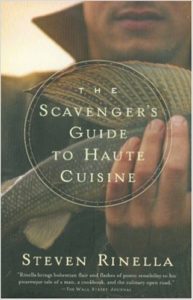
Nature writer Steven Rinella embarks on a yearlong journey across America, trying to locate the bizarre, often esoteric ingredients of Le Guide Culinaire. His adventures take him fishing for stingrays on a Florida beach; skinning eels with an upstate New Yorker who keeps an emu as company; and hunting mountain goats on the snow-covered cliffs of Alaska’s Chugach Range.
Praised by reviewers for its lyrical prose and humor, The Scavenger’s Guide to Haute Cuisine is a narrative that opens up a deeper understanding of the things we eat and our place in the natural world.
MONDAY, AUGUST 24th we convened at the home of one of our members in Palo Alto. After a tour of her abundant edible garden and a few tastings of its bounty, we sat down to a Sicilian-themed potluck dinner of recipes gleaned from our recent reading. Our host had selected Vincent Schiavelli’s two memoir/recipe books – Many Beautiful Things: Stories and Recipes from Polizzi Generoso and Bruculinu, America: Remembrances of Sicilian-American Brooklyn
Vincent Schiavelli is a character actor who has appeared in such films as “Ghost, Man on the Moon,” and “One Flew Over the Cuckoo’s Nest.” Schiavelli grew up in Brooklyn, speaking both Sicilian and English at home. His stories reflect fond childhood memories of growing up within the very tight-knit Sicilian-American community in Brooklyn.
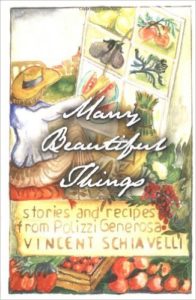
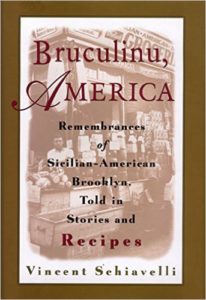
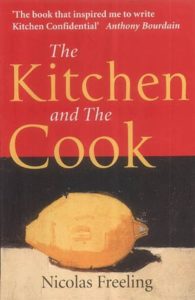 We met on MONDAY, JUNE 1, 2015 at a member’s home in Palo Alto to share a seasonal potluck repast and talk about our favorite passages in The Kitchen and the Cook by Nicholas Freeling. This memoir draws on Freeling’s experience as an apprentice cook in a large French hotel, and his subsequent work in the professional cooking field.
We met on MONDAY, JUNE 1, 2015 at a member’s home in Palo Alto to share a seasonal potluck repast and talk about our favorite passages in The Kitchen and the Cook by Nicholas Freeling. This memoir draws on Freeling’s experience as an apprentice cook in a large French hotel, and his subsequent work in the professional cooking field.
On MONDAY, MARCH 23, 2015 we gathered at a member’s house in Los Gatos to talk about our selected tome. We have selected Barbara Kingsolver‘s novel Animal, Vegetable, Miracle about her family’s various adventures moving to Appalachia and learning to live and eat very locally on surrounding lands.
Shamelessly borrowed from Amazon.com: Kingsolver’s first nonfiction narrative will open your eyes in a hundred new ways to an old truth: You are what you eat.
“As the U.S. population made an unprecedented mad dash for the Sun Belt, one carload of us paddled against the tide, heading for the Promised Land where water falls from the sky and green stuff grows all around. We were about to begin the adventure of realigning our lives with our food chain.
“Naturally, our first stop was to buy junk food and fossil fuel. . . .”
Hang on for the ride: With characteristic poetry and pluck, Barbara Kingsolver and her family sweep readers along on their journey away from the industrial-food pipeline to a rural life in which they vow to buy only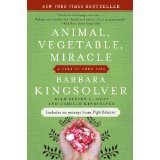
“This is the story of a year in which we made every attempt to feed ourselves animals and vegetables whose provenance we really knew . . . and of how our family was changed by our first year of deliberately eating food produced from the same place where we worked, went to school, loved our neighbors, drank the water, and breathed the air.”
MONDAY, JANUARY 26, 2015 found us together discussing Dan Jurafsky‘s book The Language of Food, A Linguist Reads the Menu at a member’s home in Redwood City. Our repast included several dishes from Jurafsky’s book, including escabeche (p. 40) (a distant cousin of the centuries old ‘sikbaj’, a vinegar-based stew of assorted meats or fish) and coleslaw (a relative of a long-ago favorite salad called ‘koolsla’ (p.124)).
As a Stanford linguistics professor, Jurafskey is conversant with the origins of language and how our vocabulary changes over time and generations as a result of geographical location, changing times and everyday practices. The author takes us on a journey through the history of food names from the perspective of its evolving nomenclature, regional diversity and uniquely social-at-the-table context.
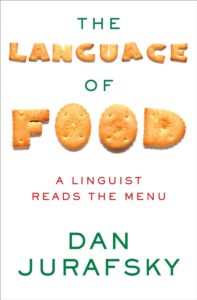
FROM AMAZON’S BOOK DESCRIPTION, A FEW WORDS OF EXPLANATION: Why do we eat toast for breakfast, and then toast to good health at dinner? What does the turkey we eat on Thanksgiving have to do with the country on the eastern Mediterranean? Can you figure out how much your dinner will cost by counting the words on the menu?
In The Language of Food, Stanford University professor and MacArthur Fellow Dan Jurafsky peels away the mysteries from the foods we think we know. Thirteen chapters evoke the joy and discovery of reading a menu dotted with the sharp-eyed annotations of a linguist.
2014 (in review)
MONDAY, OCTOBER 20th marked our fall potluck discussion of Laurie Colwin‘s Home Cooking – A Writer in the Kitchen.
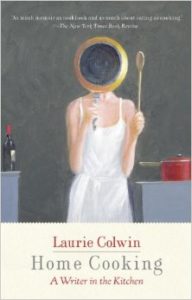
to-earth wit and colorful storytelling about all manner of relationship, kitchen and culinary adventures large and small easily draw readers into her world to share her passion for cuisine. She shares tips, recipes and tales of the many pleasures and often problematic surprises we’ve all experience in our own home cooking.
Other books by Colwin include More Home Cooking, Happy All the Time, Goodbye Without Leaving, and three collections of short stories: Passion and Affect, Another Marvelous Thing and The Lone Pilgrim.
THURSDAY, AUGUST 28th, 2014 was our late summer gathering to discuss Dan Barber’s best-selling book The Third Plate – Field Notes on the Future of Food.
Our potluck dishes reflected Barber’s theme of adapting our food preferences and eating habits to encourage varied and seasonal agricultural production of grains and crops that uniquely nourish the soil ,as well as our health. Along with a homemade pate and ratatouille, we enjoyed a faro and quinoa salad, two varieties of gazpacho. Starting out with an aged proscuitto wrapped around seasonal melon slices, our picnic ended with madeleines as the lights of the Rodin Sculpture Garden came on outside the Cantor Center for the Arts.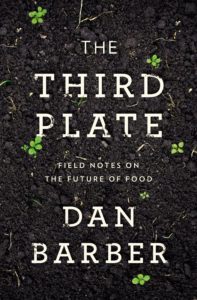
From a summary on the book’s Amazon page, following is a concise overview of what awaits the reader and what will enliven our group’s discussion…
“The Third Plate is grounded in the history of American cuisine over the last two centuries. Traditionally, we have dined on the “first plate,” a classic meal centered on a large cut of meat with few vegetables. Thankfully, that’s become largely passé. The farm-to-table movement has championed the “second plate,” where the meat is from free-range animals and the vegetables are locally sourced. It’s better-tasting, and better for the planet, but the second plate’s architecture is identical to that of the first. It, too, is damaging—disrupting the ecological balances of the planet, causing soil depletion and nutrient loss—and in the end it isn’t a sustainable way to farm or eat.
The solution, explains Barber, lies in the “third plate”: an integrated system of vegetable, grain, and livestock production that is fully supported—in fact, dictated—by what we choose to cook for dinner. The third plate is where good farming and good food intersect.
While the third plate is a novelty in America, Barber demonstrates that this way of eating is rooted in worldwide tradition. He explores the time-honored farming practices of the southern Spanish dehesa, a region producing high-grade olives, acorns, cork, wool, and the renowned jamón ibérico. Off the Straits of Gibraltar, Barber investigates the future of seafood through a revolutionary aquaculture operation and an ancient tuna-fishing ritual. In upstate New York, Barber learns from a flourishing mixed-crop farm whose innovative organic practices have revived the land and resurrected an industry. And in Washington State he works with cutting-edge seedsmen developing new varieties of grain in collaboration with local bakers, millers, and malt makers. Drawing on the wisdom and experience of chefs and farmers from around the world, Barber builds a dazzling panorama of ethical and flavorful eating destined to refashion Americans’ deepest beliefs about food.”
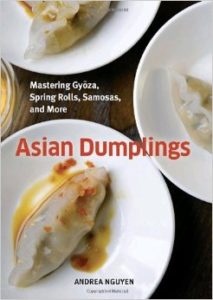
While sipping wine, sampling a pulled pork banh mi, and sharing laughter, we used tortilla presses and several homemade fillings (pork, shrimp and a veggie option with onions and mushrooms) to create our own pan-Asian sampling of dumplings. Recipes from Andrea’s book provided our inspiration and we talked about favorite places in the South Bay to find dumplings and banh mi.
Our MARCH 31st, 2014 reading was The Man Who Ate Everything (And Other Gastronomic Feats, Disputes and Pleasurable Pursuits) by Jeffrey Steingarten. An entertaining collection of essays by the “internationally feared and acclaimed food critic” (formerly) of Vogue magazine. Steingarten has also been a contributor to the online Slate.com.
Steingarten. An entertaining collection of essays by the “internationally feared and acclaimed food critic” (formerly) of Vogue magazine. Steingarten has also been a contributor to the online Slate.com.
Many of the essays included in this volume were previously published as articles for the above-mentioned and have received awards from the James Beard Foundation and the International Association of Culinary Professionals. A world foodist and traveler, many cuisines and famous – as well as infamous – dining destinations are the focus of Steingarten’s witty tales of eating and cooking adventure.
Our JANUARY 2014 reading was A Family Farm in Tuscany: Recipes and Stories from Fattoria Poggio Alloro by Sarah Fioroni and translated by Natalie Danford. Including traditional family recipes and colorful photography throughout, this is a story about three generations of one family 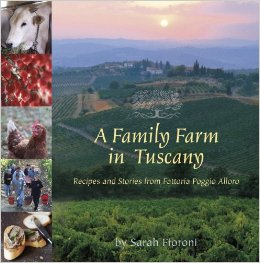
Good Food Reads: Past Selections
97 Orchard: An Edible History of Five Immigrant Families in One New York Tenement by Jane Ziegelman.
Salt, Sugar, Fat by Michael Moss
The Gastronomical Me by MFK Fisher
Twain’s Feast by Andrew Beahrs
Farm City by Novella Carpenter
Endless Feasts: Sixty Years of Gourmet by Ruth Reichl, Ed.
Four Fish by Paul Greenberg
Blood, Bones and Butter by Gabrielle Hamilton
The United States of Arugula by David Kamp
The Tummy Trilogy by Calvin Trillin
Life, on the Line by Grant Achatz
The Fortune Cookie Chronicles by Jennifer Lee
The Dirty Life by Kristin Kimball
Maman’s Homesick Pie by Donia Bijan (a local author and chef!)
Reading Between the Wines byTerry Theise
Climbing the Mango Tree by Madhur Jaffrey
Death by Pad Thai by Douglas Bauer
~ Reviews: A Few Past Books ~
Tuesday, March 29, 2011: Endless Feasts: Sixty Years of Writing from Gourmet, edited by Ruth Reichl
Summary submitted by Linda Collery;Slow Food South Bay’s Food Literature Group ventured forth on its first field trip to attend Ruth Reichl’s recent talk “The Intersection of Food, Culture and History” at Stanford University. As the title suggests, Reichl’s presentation was wide-ranging and eclectic in scope. She began and ended her talk by reading from two very different female food writers whose books span a sixty-four year period – first from MFK Fisher’s bookThe Gastronomical Me (the first selection to be read by SFSB’s food literature group) and then concluding with a passage from chef/writer Gabrielle Hamilton’s new book, Blood, Bones and Butter. In between, Reichl’s lecture touched on Apicius, Allen Ginsburg, the Ming Dynasty, Chef Antonin Careme, the first edition of theJoy of Cooking, writers AJ. Leibling and Joseph Mitchell and the wonderful poem by William Carlos Williams, “This is Just to Say.” Reichl stated that food is a reflection of its time and when one reads about food, one learns about the history and culture of a place.
She observed that there currently seems to be a voracious appetite for food writing. She believes that the less we cook as a culture, the more we desire to read and watch television about food instead. During the question/answer segment at the end of her presentation, Reichl touched on some fascinating topics. She stated that “it is important and an act of bravery” to invite people into your home for meals. She believes people get to know you in a way that they never will elsewhere. Reichl was asked about Ruth Bourdain, the tweeter who was recently nominated for a James Beard Award in humor. Ruth Bourdain is a mash-up between Reichl and Anthony Bourdain – Reichl’s tweets are rewritten in the voice of Anthony Bourdain. No one knows who this individual is, but given the hilarity of Ruth Bourdain’s tweets, Reichl hopes he or she will win.
Reichl just happened to be speaking at Stanford the very same evening the food lit group was slated to discuss Endless Feasts: Sixty Years of Writing from Gourmet, edited by Ms. Reichl. The group decided this fortuitous coincidence was just too good to pass up.
Afterward, we met at Siam Orchid in Palo Alto for a light meal to discuss Endless Feasts. The general consensus was that this collection of essays from Gourmet was an excellent introduction to many impressive food writers. The quality of writing revealed what a true gem Gourmet was over the many decades of its publication.
Monday, September 27, 2010: Twain’s Feast by Andrew Beahrs
Summary submitted by Linda Collery
Berkeley author Andy Beahrs joined the second meeting of Slow Food South Bay’s new food literature group in September. Andy is the author of Twain’s Feast, a book about America’s lost wild foods as seen through the eyes of a homesick Mark Twain. In 1879, Twain was more than a year into a tour of Europe that was described in his book A Tramp Abroad. Twain found that he detested European hotel cooking. He missed his native cuisine so much that he created a fantasy menu of American foods. It was comprised of approximately eighty regional specialties, revealing the incredible wealth of local and fresh American foods in the 1800s. Twain’s menu included Lake Trout from Tahoe, Hot Biscuits, Southern Style, Black Bass from the Mississippi, Roast Wild Turkey, Hot Buckwheat Cakes, Clear Maple Syrup, Peach Cobbler and Pumpkin Pie. The eighty-item menu alone is worth the price of the book! Each of Andy’s chapters delves into one of the foods on Twain’s menu in depth, such as cranberries, oysters and mussels from San Francisco and prairie hens.
Andy gave a wonderful reading from his chapter on maple syrup. He then led us in a maple syrup tasting. The syrup was predominantly from River’s Edge Sugar House, a small, artisanal producer located in Connecticut, a state where Twain lived during one of the happiest periods in his life. We tasted several River’s Edge Grade A syrups, ranging from Light to Dark Amber as well as their Grade B syrup. We also tasted one of Trader Joe’s house syrups. The difference in quality was truly astonishing.
Reviewed by Peter Ruddock
Like most Americans, I’ve read some of Mark Twain’s books. I’ve read The Adventures of Tom Sawyer and Adventures of Huck Finn, of course. And I’ve read some of Twain’s travel writing, including Innocents Abroad. I never would have thought of Twain as a food writer.
Fortunately, author and Slow Food Berkeley member Andrew Beahrs thinks differently. Then again, he has apparently read more of Mark Twain’s writing than most and he knows that Twain was serious about food. He illustrates this most explicitly with a quote from Twain, using a line that he attached to a letter from his wife to a friend of hers as a postscript: “Dear Mrs. H – If I have a talent it is for contributing valuable matter to works upon cookery.”
In the Introduction to Twain’s Feast, his third book and first work of non-fiction, Andy tells us about a list that Mark Twain made while living in Germany and missing home. It described a meal, a “modest, private affair” just for himself. This meal included about eighty items of American food, from things as simple as radishes and new potatoes, to more substantial fare, like “Blue points, on the half shell” and “Canvas-back-duck, from Baltimore.” Many of the foods were prepared “Southern style.” The meal finished with apple pie, pumpkin pie and other American sweets, of course.
Out of this list for a meal sprung Andy’s idea for a book. He pared his literary feast to eight items, some of which are no longer eaten much in America: prairie hens, raccoon, Sheep-head (a fish common in Louisiana) and terrapin (a kind of turtle from the east coast); others of which are still common: trout, cranberries and maple syrup. And probably of most interest to readers in the Bay Area: San Francisco Bay oysters. Substitute Tomales Bay for San Francisco Bay in the twenty-first century and you know, pretty much, what he’s talking about.
For each food, Andy takes us on a tour, showing us the food as Twain would have known it, telling us about its geography and culinary uses at the end of the nineteenth century. With a mixture of history, biography and natural science we are introduced to the plant or animal as an American would have recognized it after the Civil War. Using recipes, similarly to the way that Mark Kurlansky does in his books, we are also introduced to how the food would have been prepared and served in an American house, such as Mark Twain’s.
Andy then brings us into the present, contrasting the foods as they are now known with how they were known in Twain’s era. The differences can be shocking – while we don’t eat raccoon mostly based on sensibility, we would likely eat prairie chicken if there were enough of them to eat. In the twenty-first century, the tale often becomes one of the environment, illustrating what we’ve lost in the last century and a half and why we’ve lost it.
But this is a book by a Slow Food member, so the cautionary tale is leavened with celebration. Andy’s love of food and cooking comes through when he talks about his own experiences with food and meals he ate and cooked while writing the book. And he had some wonderful experiences in the process – for each food he traveled somewhere in the United States to meet someone who is working with the plant or animal, often in a sustainable manner, and often with great passion. The descriptions of these individuals and their projects are some of the strongest passages in the book.
The book has just been released, but you ought to be able to find it in your local (independent) bookstore, or in your library. Do look for it. This is a book that all Slow Food members will enjoy reading. Slowly, of course.
Monday, June 28, 2010: The Gastronomical Me by M.F.K. Fisher
Summary submitted by Allison McElwee
We would like to thank Linda Collery for hosting the first meeting of Slow Food South Bay’s quarterly book group at the Mountain View Community Center. The book of the evening was MFK Fisher’s memoir, The Gastronomical Me. It describes her travels and experiences with food as a woman in the early 1900’s. The meeting consisted of a themed potluck and discussion. Attendees all brought food items that were mentioned in the book. Some even used Fisher’s recipes. While munching on treats like gingerbread, the group had a fun discussion about Fisher’s experiences, Fisher herself, as well as their own experiences with food.
